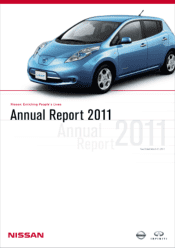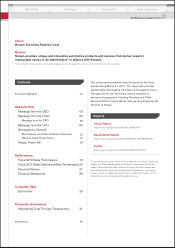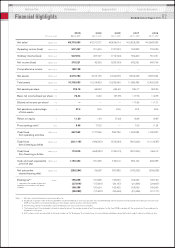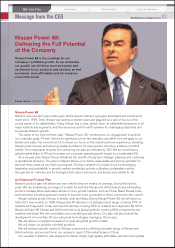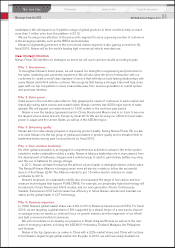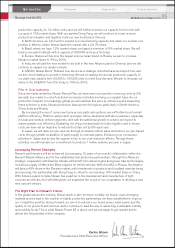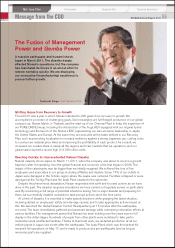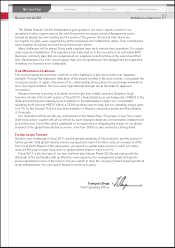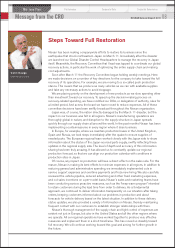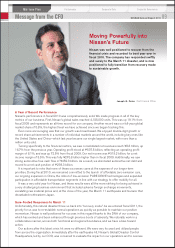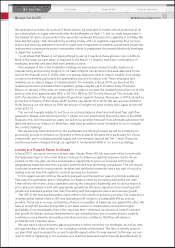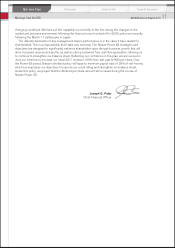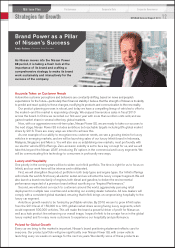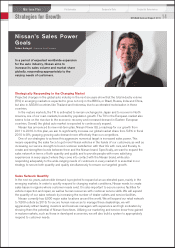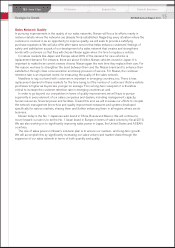Nissan 2011 Annual Report Download - page 7
Download and view the complete annual report
Please find page 7 of the 2011 Nissan annual report below. You can navigate through the pages in the report by either clicking on the pages listed below, or by using the keyword search tool below to find specific information within the annual report.
Shifting Gears from Recovery to Growth
Fiscal 2010 was a year in which Nissan intended to shift gears from recovery to growth. We
accomplished a number of challenging goals. Some examples are full-fledged production of our global
compact car, Nissan March, in Thailand, and the start-up of our Chennai Plant in India; the expansion of
our PURE DRIVE lineup, including the introduction of the Fuga HEV equipped with our original hybrid
technology; and the launch of the Nissan LEAF, representing our zero-emission leadership, in Japan,
the United States and Europe. At the same time, we executed all the tasks defined in our Recovery
Plan, such as promoting localization to increase resilience against a strong Japanese yen, cutting costs
to counter raw material price hikes and improving the profitability of each product. As a result, we
increased our market share in nearly all the regions and main markets that we operate in, and our
global sales reached a record high of 4.185 million units.
Reacting Quickly to Unprecedented Natural Disaster
Natural calamity struck Japan on March 11, 2011, when the company was about to resume a growth
trajectory after recuperating from the global financial and economic crisis that began in 2008. The
impact of the catastrophe was far bigger than we initially imagined. We suffered the loss of five
employees and associates in our group, including affiliates and dealers. Some 17% of our outlets in
Japan were damaged in the Tohoku region where the quake was centered. Facilities collapsed or were
damaged at the Tochigi Plant and the Iwaki Plant nearest to the epicenter.
Despite the phenomenal devastation, Nissan responded with swift and focused actions as we have
done in the past. The disaster response simulations we have carried out regularly served us particularly
well. By envisioning a full range of potential situations arising from a major disaster and preparing for
them, we successfully enabled ourselves to take prompt actions when the time came.
At a time of disaster, it is essential to make speedy decisions while grasping the latest situation,
including details on employees’ safety and damage caused, and to take appropriate actions based on
this. We launched the Global Disaster Control Headquarters just 15 minutes after the earthquake
occurred. The team immediately gathered and assessed damage while overseeing restoration efforts at
various facilities. The management power that Nissan has been building over the years was on full
display in the initial stages. Hundreds of people from other plants were mobilized to take part in
restoration work at affected facilities. Thanks to their hard work, we restarted production at all our
vehicle plants in Japan one month after the earthquake. The Iwaki Plant, which was the hardest hit,
resumed full operations on May 17, and is ready to produce at a pre-earthquake level as long as
necessary parts are supplied.
Toshiyuki Shiga Chief Operating Officer
A massive earthquake and tsunami shook
Japan in March 2011. The disaster deeply
affected Nissan’s operations, but the company
has marshaled its forces in an all-out effort to
restore normalcy quickly. We are displaying
our monozukuri (manufacturing) excellence to
pursue further growth.
The Fusion of Management
Power and Gemba Power
Message from the COO
Mid-term Plan
Performance Corporate Data Corporate Governance
06
NISSAN Annual Report 2011

